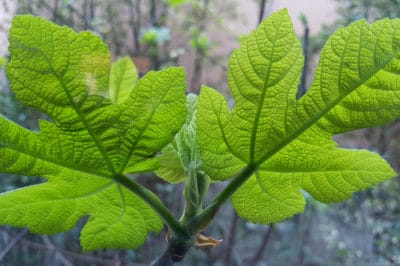About Fig Trees
The fig family includes over 700 kinds of plants, from 50-foot tall trees to small figs used as houseplants or bonsai specimens. The unusual fruit develops from an inverted flower and must ripen on the tree. Mostly Mediterranean natives, figs grow well in USDA Zones 5 to 11, depending on the variety, and as houseplants. They are not fussy about soil, require little fertilizer and are drought-tolerant.
Types of Fig Leaves
Fig leaves are grouped into five basic shapes. The also vary in size, texture and color, and may be lobed. The basic shapes are:
- Oval with smooth edges.
- Undulate – oval with dents and curves.
- Truncate – leaf base perpendicular to the leaf and straight.
- Decurrent – leaf extends downward along the stem.
- Cordate – leaf is heart-shaped.
Identifying Figs by Their Leaves
Fig leaves can be useful in identifying fig varieties. For example, the fiddle leaf fig has glossy, bright green leaves with undulate edges and a shape that resembles a violin. The common edible fig has a broad, light green leaf with five deep lobes and a slightly hairy texture. Weeping figs have evergreen, elliptical leaves with smooth edges.
Yellow Fig Leaves
Many figs are deciduous, so it’s normal for leaves to yellow and fall in the autumn months. Stress is the most common reason for yellow fig leaves to occur in other seasons. Too much or too little water can stress the tree. Excess fertilizer is another potential cause – figs don’t need much. Transplant shock and insect infestation are other possibilities.
Dropping Fig Leaves
A certain amount of leaf drop is normal in fig trees. If these leaves are replaced by healthy green leaves, don’t worry. The tree will also shed its leaves in the fall. Leaves that yellow and drop at other times can be caused by environmental conditions or insect problems. Too much or too little water, excess fertilizer or sudden, dramatic temperature changes can all cause leaf drop.
Using Fig Leaves
Fig leaves are most often used to wrap foods such as fish or vegetables and rice for cooking. A traditional folk medicine remedy for ulcers is to chew and swallow two fig leaves daily. They can also be made into a tea by boiling the leaves in water for 15 minutes. Fig leaves can lower insulin requirements and reduce triglycerides, and have been used to treat bronchitis.
